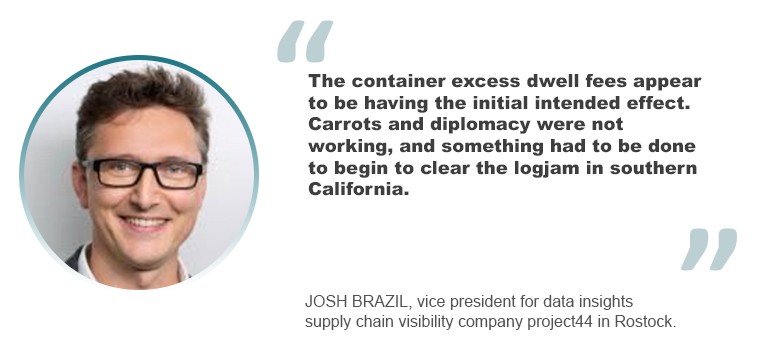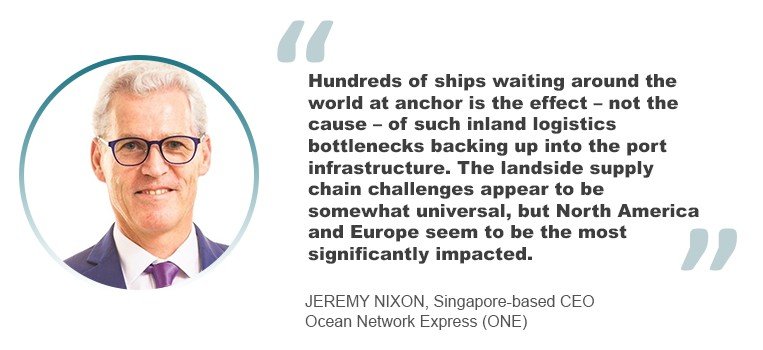Shippers appeared supportive of new measures currently being implemented at the ports of Los Angeles and Long Beach to ease persistent congestion issues ahead of the peak season at North America’s busiest cargo ports.
Analysts also noted improvements in cargo movements at the ports as U.S. authorities proposed in the last week of October new emergency fees on cargo stuck on the terminal at the ports of Los Angeles and Long Beach, as part of the federal government’s efforts to alleviate the severe congestion in the area and the subsequent imposition of a new programme of excess container dwell fees on October 29 – although warning this is no silver bullet to end months of port congestion.
“The container excess dwell fees appear to be having the initial intended effect,” said Josh Brazil, the Rostock-based vice president for data insights at supply chain visibility company project44. “Carrots and diplomacy were not working, and something had to be done to begin to clear the logjam in southern California.”

“The fees will not be a silver bullet that will solve the congestion altogether, but even if it even gets 20% of the containers cleared it will help break the stalemate logjam.”
So far, he noted, a terminal in Tacoma also recently announced similar fees – but that they would be imposed the cargo ownern rather than the carrier. “The idea seems to be gaining traction,” Brazil said.
Phillip Sanfield, port of Los Angeles spokesperson, told Asia Cargo News of improvements in numbers at the port following the implementation of the measures.
He said on October 24 – the night the ports announced excess container dwell fees of US$100 on the first day past the dwell limit, which will escalate by US$100 increments for each subsequent day – there were 94,981 import containers on the POLA terminals. Of those, 37,410 import containers had sat there for nine days or longer.
But as of November 8, Sanfield reported that there were 75,283 import containers on POLA terminals, a 21% reduction since the October 24 imposition of excess dwell fees. By November 29, the ports have seen a combined decline of 37% of aging cargo on the docks.
“This is a reflection of all nodes of the supply chain, from the shipping lines to the marine terminals to the truckers, and cargo owners working in sync. By reducing the amount of cargo sitting on the terminals, this allows for more ships to come into the port to discharge their cargo,” he added.
Sanfield said the port has not started invoicing the fee yet, which was supposed to start on November 15; on November 29, the ports announced a further postponement of the fee, and that they would not consider implementing it prior to December 6.
“[All sides are] working as quickly as possible. We’re moving record amounts of cargo,” Sanfield said.
Shippers support port congestion measures
“These charges are intended to incentivize the removal of long-dwelling containers as part of a wider U.S. initiative to manage congestion from the record volumes of cargo being moved by shippers into the country. They are not intended as ‘fines’ on carriers,” MSC said in a statement.
“MSC expects that all costs will be passed through to shippers, although it remains unclear whether the Marine Terminal Operator (MTO) or the carrier will be rebilling this,” it added, noting that in the meantime, the ocean carrier continues to do all that it can to provide solutions to its customers in respect of the significant challenges facing global supply chains and the specific stress in the Los Angeles/Long Beach area.
ZIM Integrated Shipping told Asia Cargo News separately that it is working closely with its customers in North America to “speed up” the pick-up of containers at ports.
“We are taking all possible measures in our control to reduce the number of containers in the terminal. ZIM will work closely with our customers to speed up customers’ container pick-up from the terminal, to avoid getting into the fee period,” it added.
For its part, Hong Kong-based OOCL said it is following the issue on container excess dwell fees “very closely.”
“We believe it is critical that all involved parties work together to ease the current bottlenecks in the supply chain,” the shipping line said. “We are ready to cooperate with all initiatives that attempt to facilitate this objective.”
Waiting ships ‘not the cause of bottlenecks’
Jeremy Nixon, the Singapore-based CEO at Ocean Network Express (ONE) pointed out that waiting ships are the “effect, not the cause, of bottlenecks.”
In an update on its FY’21 Q2 initiative, Nixon noted that waiting ships around the world are the result of inland logistics bottlenecks. He said the company continued to see bottleneck constraints as a result of landside labour shortages and high consumer and industrial demand for products.
“Hundreds of ships waiting around the world at anchor is the effect – not the cause – of such inland logistics bottlenecks backing up into the port infrastructure. The landside supply chain challenges appear to be somewhat universal, but North America and Europe seem to be the most significantly impacted,” Nixon said.

No holiday delays?
Meanwhile, ahead of the peak season, project44’s Brazil said many holiday goods are already waiting on board several ships to be unloaded at the West Coast ports, allaying fears of delays for holiday deliveries.
“If there are any orders missed and have not been loaded already [in Asia], there will surely be delays as ships still have to return to the Far East and come back with more goods. But judging by the fact that warehouses are full, there may not be delays on the warehouse delivery side,” he said. “Smaller customers may have a higher percentage of delays as their cargo may not have been prioritized by the carriers due to volume-based business.”
He also pointed out that lack of container storage space at inland facilities is causing port congestion issues at major West Coast ports.
“Apart from the consumer demand side, the supply problem is lack of container storage space at inland facilities. If the demand continues at these levels beyond the holiday season, overflow storage space would need to be identified at an inland location within driving and rail distance of the port to act as a relief valve,” Brazil told Asia Cargo News.
Congestion to persist to 2022
Moving forward, Brazil said the port congestion issues will likely spillover to next year.
“This problem is well set to continue into 2022,” the analyst said. “We will have to see how much demand drops off after Chinese Lunar New year. If strong demand persists, more containers and more vessel capacity will be needed, but that will not begin to happen until 2023.
Charlee C. Delavin


-x-large.jpg)
